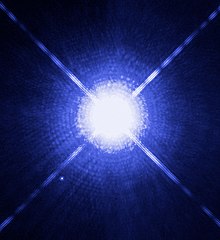Artefakt (fejl)
 For alternative betydninger, se Artefakt. (Se også artikler, som begynder med Artefakt)
For alternative betydninger, se Artefakt. (Se også artikler, som begynder med Artefakt)

Guldtand absorberer røntgen i CT-scanner
Artefakter anvendes også om systematiske fejl på og i signaler og hardware; CCD-chips, i optik og tilsvarende teknik.
Medier brugt på denne side
CT tooth artifact.jpg
actifact caused by total absporption of X-Ray in head CT scan
actifact caused by total absporption of X-Ray in head CT scan
Digital camera artifact.jpg
Forfatter/Opretter: Brocken Inaglory, Licens: CC BY-SA 3.0
Crepuscular rays and lens flare. The Sun refracted in lenses.
Forfatter/Opretter: Brocken Inaglory, Licens: CC BY-SA 3.0
Crepuscular rays and lens flare. The Sun refracted in lenses.
Sirius A and B Hubble photo.jpg
This Hubble Space Telescope image shows Sirius A, the brightest star in our nighttime sky, along with its faint, tiny stellar companion, Sirius B. Astronomers overexposed the image of Sirius A [at centre] so that the dim Sirius B [tiny dot at lower left] could be seen. The cross-shaped diffraction spikes and concentric rings around A*, and the small ring around Sirius B, are artifacts produced within the telescope's imaging system. The two stars revolve around each other every 50 years. Sirius A, only 8.6 light-years from Earth, is the fifth closest star system known. The image was taken with Hubble's Wide Field Planetary Camera 2.
This Hubble Space Telescope image shows Sirius A, the brightest star in our nighttime sky, along with its faint, tiny stellar companion, Sirius B. Astronomers overexposed the image of Sirius A [at centre] so that the dim Sirius B [tiny dot at lower left] could be seen. The cross-shaped diffraction spikes and concentric rings around A*, and the small ring around Sirius B, are artifacts produced within the telescope's imaging system. The two stars revolve around each other every 50 years. Sirius A, only 8.6 light-years from Earth, is the fifth closest star system known. The image was taken with Hubble's Wide Field Planetary Camera 2.




